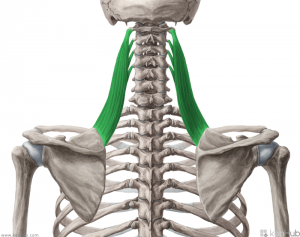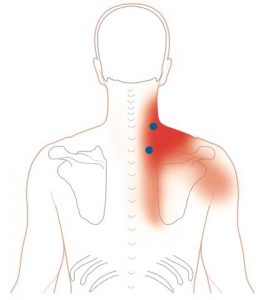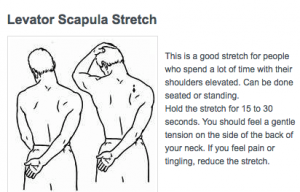Levator Scapulae Syndrome
Levator Scapulae Syndrome: Causes, Symptoms & Treatment
Introduction
Levator Scapulae Syndrome is an historical name for “pain over the upper medial angle of the scapula”
Levator scapulae pain is one of the most common general muscle complaints. Understanding the levator scapulae is helpful for both preventing and treating levator scapulae pain.
Anatomy

The levator scapulae muscles are located on either side of the neck. It attaches at the top corner/angle of the scapula – called the angulus superior – and at the first four vertebrae of your cervical spine.
Levator Scapulae Function
The duties of this muscle are many. First, as the name suggests, it helps to elevate your shoulder and rotating the scapula downwards. When the levators of both shoulders are activated, they help to bend your neck backwards and to stabilize it when you look downwards. Furthermore, it rotates your neck and bends it to the same side that is active and is supplied by a nerve in the cervical spine area.
Sign and Symptoms
levator scapulae, can give you pain right at their location and send it to other, seemingly unrelated areas of your body. The main pain zones of the levator scapulae are the side of your neck and your upper shoulder. But this muscle is also capable of sending pain to your shoulder blade and along its inner border – which is called margo medialis
Some healthcare providers describe people with levator scapulae pain as individuals who “walk like Frankenstein.” They aren’t making fun of these individuals; they are trying to explain what it’s like.

It can contribute to the following aches:
- Deep, achy pain and/or tightness on the upper back along the top of the shoulder blade or neck.
- Painful neck and impaired movement: It can be painful to turn the head fully or lift the neck when you’re in a lying position. Some people have to support their neck with their hands when they attempt to get up.
- Neck pain, which may extend to the head causing a headache.
- Shoulder blade pain and pain between shoulder blades
An elevated shoulder: Usually one shoulder blade is held a little higher than the other, which can be seen from the back.
What Causes Levator Scapulae Pain?
Based on the explanation above, you can imagine levator scapulae action. This muscle can get worked a lot on a daily basis, but having levator scapulae syndrome – which basically means the area is irritated and inflamed – can be terribly uncomfortable and rather restricting. Those who suffer from levator scapulae chronic pain are forced to give up activities that they enjoy since they can activate trigger points in the muscle upon movement.
The following list covers some of the levator scapulae pain causes
- Working at a computer with the head turned
- Emotional/mental stress
- Carrying heavy bags with a shoulder strap
- Chilling of the muscle during sleep from a ceiling fan or air conditioner
- Holding a phone between the shoulder and ear for too long
- Sleeping on your stomach with your head turned
- Head forward posture
- Cervical spine dysfunction.
- Repetitive arm motions such as in swimming, throwing, or racquet sports.

The cause could be an injury to simple daily strain. Strain is an increased tightness and tension in a muscle from contraction of the muscles over a long period of time. Without treatment, it can cause limited range of motion for the neck, shoulders and arms and is often the cause of tension headaches. Accompanying medical problems can include depression, anxiety and general fatigue. Some shoulder pain arises from holding a phone to your ear; for tiny cell phones, this can be especially difficult, causing more pain and stiffness. For women, carrying bags with straps over the shoulder is another common cause of levator pain.
If you overstress this muscle, it will let you know. You will have a hard time turning your head fully to the side without pain. This is what most people experience when they are complaining about a stiff and painful neck. Lying on a sofa or in bed and lifting the neck can be so painful that you have to support your head with your hands. This is especially annoying when you want to change the position of your head on the pillow in order to get a comfortable sleeping position. Tilting your head forwards in order to read a book also can become painful.
I want to relieve my pain
Lifting and carrying heavy weights is not kind to the shoulders and the levator scapulae.Both tasks pull your shoulders downwards. As the levator wants to stabilize them, it contracts to keep them in place. It will do a good job as long as it can, but if the weight becomes too high or the duration of the stress too long or frequent – e.g. carrying your purse every day on the same side – the muscle reacts. It starts to tighten up permanently. This is its way of withstanding the stress you are placing on it.
Looking upwards for a long time is very unnatural too and is a difficult task for your neck muscles. If you do it – like a belayer in rock climbing – the levators have to work hard and start to cramp and tighten up. Do it too often and the tightness may become a permanent condition. This is when the trouble starts. Reading with your head facing downwards is the opposite stress.
The levators have to stabilize your neck and prevent it from tilting forward too much. Usually this does not trouble your levators a lot, but forcing them to do this for several hours is just too much for most people. Thus a seemingly easy task becomes damaging. Here it is not the immediate task itself that causes trouble, but its duration.
How to Treat Levator Scapulae Pain
Levator scapulae pain treatment involves several different potential options.
Consider some of these treatments:
- Electrical stimulation: This can relax the strained muscle. It involves applying a small amount of current to the stressed muscle.
- Massage: Having a levator scapulae massage is said to be one of the best ways to relax this muscle and the surrounding area.
- Osteopathy: Adjustments can be performed anterior to posterior or lateral to medial, depending on the position of the injured muscle.
- Stretching: Often times, a levator scapulae stretch can be helpful along with some of the other treatment approaches, such as massage.
- Posture adjustments: Learning proper sitting positions if the problem was caused by poor posture can make a big difference. When sitting, make sure your upper back and neck are not hunched over.
- Over-the-counter medications: There are some over-the-counter pain relievers that can help control pain.
Helpful Exercises
Exercise helps alleviate many posture and strain issues. Shoulder shrugs with hand weights or resistance bands are a great way to strengthen the levator scapulae muscles.

Shoulder shrugs
Keeping your arms by your side, rotate the shoulders in a wide circular motion 10 to 15 times in each direction. Make sure to stretch after you exercise. The best way to stretch the levator scapulae is to tilt the head at a 45-degree angle while simultaneously lowering the opposing shoulder. Repeat both sides, and hold the stretch for at least 30 seconds.
Sit Up Straight
Like your mother always said, sit up straight. Posture is key to a healthy neck and spine. With untold hours spent at a desk or computer, many Americans have poor posture. To correctly align the neck and spine, make sure your ears are directly over your shoulders, your shoulders are back and your pelvis is in neutral position. This can be found by standing with your feet about hip width apart and tilting your hips all the way forward then all the way back; the point between the two is your neutral posture. At the office, take many small breaks to walk around and stretch; every 30 to 45 minutes is ideal.
Colgan Osteopathy in Kettering Northamptonshire
Colgan Osteopathy in Hatfield, Hertfordshire
To book an appointment, call 07738493974 or book online